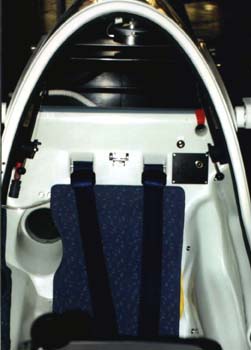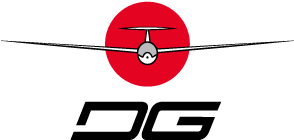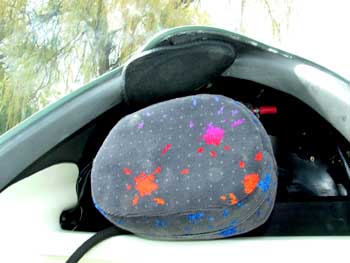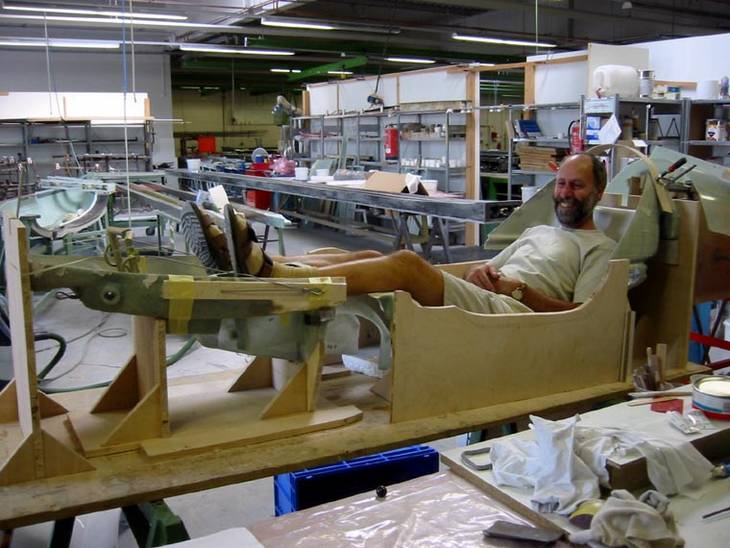At each AERO Exhibition I noticed again how many young people are taller than previous generations were. And when a two-meter-tall man tries to squeeze himself into a cockpit it really looks tight.
What can be done?
On one hand DG cockpits are relatively roomy – especially the two seaters. And yet we would make the front part of the fuselage larger, if we had to develop a new fuselage. It would be slightly wider, in spite of the slightly higher drag, to give more comfort, and slightly longer, to provide a crash zone in front of the feet. But that is music for the future.
But we can do something for the taller DG 800 pilots. The following possibilities are worth considering as proposals. We cannot offer a universal package, because the requirements of each pilot are different. It is not just important how tall he is, but also how long his legs are in relation to his upper body, where his “central hinge” might be.
Here are our recommendations:
- The most important is the removable head rest.
Usually the head rest is an integral part of the rear seat back. The removable head rest is mounted separately in the baggage compartment and offers two advantages:
For especially tall pilots this makes more room, because the upper part of the seat back is missing.
And the head rest is adjustable in flight, adding extra comfort.
Because of this we have been able to accommodate customers 1.98 m tall with more comfort.
With and without removable headrest
 |
 |
- As a next step we can also leave out the back rest shown in the picture, giving an additional centimeter of extra space.
- As a new development another modification of the head rest is available, which brings to pilot´s head a little bit more backwards. By doing this he will need a special cover above the Roeger Hook, to avoid violations.
- The seat cushion that reaches in U shape under the knees of the pilot can be replaced with an extra thin one with thicker bolsters under the calf’s.
- If the legs have to be pulled up more we have knee bolsters to leave the legs more relaxed.
- Selecting the proper parachute is very important. It could be a flat seat parachute no thicker than the seat cushion it replaces (i.e. Slimpack, or similar to Security 350). Or a flat backpack parachute that fits into the backrest support which becomes visible when the backrest is removed.
Another new possibility is described in a special Technical Note: It is an optional modification of the rudder pedals. If you do not need to adjust the pedals, we can change the installation to bring them 3 cm forward – and that is a lot!
- The choice of the correct shoes is also important. Because it is unlikely that you would get cold feet in a DG-808 you should wear very thin, soft, black shoes such as sneakers. That gives your feet maximum room and avoids scratching the canopy. Dark socks and black jeans avoid reflections.
- In order not to feel the rudder pedals through thin-soled shoes, please use our Pedal-attachment. You can gain another 5 mm for larger feet if you cut off the front 10 cm of the carpet-felt.
- And the latest development is a smaller instrument panel, so a pilot with extra long legs and knee bolsters will not touch the panel.
All these action together already allowed pilots with a height of 203cm
sitting quite comfortable in a cockpit of a DG-808C.
Contact our Sales Manager if you have more questions.
A Tall Pilot’s Visit:
We had a visitor in Bruchsal by a Mr. Troester who is a very tall scientist. We immediately asked him to “try on” in one of our gliders. Here are the results as reported by Wilhelm Dirks:
Dear Friedel,
Today we tried fitting Herr Troester (6 ft. 6½ in. tall) into a DG-808 cockpit. He fit in comfortably without the seatback, a thick seat cushion and a normal parachute. (There was no Thin-Pack available.)
In his opinion he had very long legs but a normal upper body. The long legs were no problem. His knees did not touch the instrument stack. A person with a longer torso would have also fit using a Thin Pack parachute and a suitable seat cushion.
It would be best if interested customers tested cockpit fit themselves.
Wilhelm Dirks
Leiter der Entwicklung / Chief of Design.
In the meantime we already built a mock up, made of wood and some original spare parts. We want to estimate the cost of making a new complete fuselage mold. If we ever make this, is absolute unsure in the moment, but it might be interesting to have a look into our modeling department.
Please note the distance between the shoes and the pedals…..!


 Another new possibility is described in a special Technical Note: It is an optional modification of the rudder pedals. If you do not need to adjust the pedals, we can change the installation to bring them 3 cm forward – and that is a lot!
Another new possibility is described in a special Technical Note: It is an optional modification of the rudder pedals. If you do not need to adjust the pedals, we can change the installation to bring them 3 cm forward – and that is a lot!